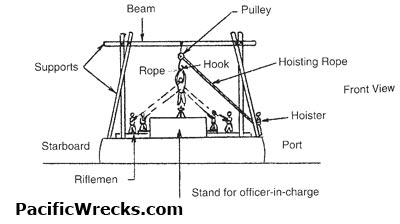|
|
|
| Missing In Action (MIA) | Prisoners Of War (POW) | Unexploded Ordnance (UXO) |
| Chronology | Locations | Aircraft | Ships | Submit Info | How You Can Help | Donate |
|
| IJN Minekaze-class destroyer 1,234 Tons (standard) 1,367 (loaded) 319' 11" x 336' 7" x 29' 3" 4 x 120mm guns 6 x 21" torpedo tubes 2 x 7.7mm MG 16 x mines  IJN circa 1923  AWM March 18, 1943 |
Ship History Built by Mitsubishi shipyards at Nagasaki. Ordered 1918. Laid down June 7, 1920 as Minekaze-class destroyer. Launched December 14, 1920 as Akikaze 秋風 meaning "Autumn Wind" in Japanese. Commissioned September 16, 1921 in the Imperial Japanese Navy (IJN). Afterwards, assigned to the Yokosuka Naval District to Destroyer Division 4, Torpedo Squadron 1 with sister ships Hakaze, Tachikaze and Hokaze. During 1938-1939 participates in the Second Sino-Japanese War patrolling off the coast of central China. In 1941, under the command of LtCdr Takuji Mori assigned to Destroyer Division 34 (DesDiv 34) with Hakaze and Tachikaze, Eleventh Air Fleet. Wartime History On December 7, 1941 departs Takao Harbor (Toshien Harbor) to perform air-sea rescue duty in support of the initial air raids against the Philippines. On December 13, 1941 escorts Kamogawa Maru from Takao to Legaspi and returns ten days later. On December 26, 1941 escorts a convoy from Takao to Davao then operates from that location performing patrols and escort duty. On December 28, 1941 Akikaze and army cargo ships Kamogawa Maru and Komaki Maru are damaged by marine casualties east of Luzon. On January 24, 1942 ecorts a convoy from Davao to Takao then returns thirteen days later. On February 8, 1942 escorts a convoy from Davao to Ambon then operates from that location performing patrols and escort duty. At the start of the Pacific war, Akikaze departs Takao Harbor to provided air-sea rescue during the initial attacks on the Philippines during December 7-12, 1941. Execution of civilian prisoners On March 8, 1943 departs Rabaul via Kavieng then to Wewak. On March 14, 1943 an Allied submarine, likely USS Triton (SS-201) attacks the destroyer near Kairuru Island without causing damage. On March 15, 1943 at Kairuru Island Navy garrison embarks Divine Word missionaries including Bishop Loerks, six priests, 14 brothers, 18 sisters and another woman with her two children aboard Akikaze. The passenger were treated with dignity, even given a rear cabin and served tea, water and bread. The destroyer's doctor treats their sea sickness with medicine. Afterwards, departs northward and overnight anchors off Lorengau on Manus Island. On March 17, 1943 twenty more civilians were brought aboard from Manus including German missionaries, one Hungarian missionary and Chinese civilians including six woman. Now there were a total of sixty civilians and prisoners aboard the ship. On March 18, 1943 Akikaze briefly anchored off Kavieng and accepted a message, then departed bound for Rabaul. While at sea, Captain Lt. Commander Sabe assembled all officers, and informed them that 8th Fleet HQ ordered them to dispose of all the prisoners. He commented that the order was regrettable, but must be carried out because it was an order. While steaming to Rabaul, all the civilian prisoners were moved to the forward cabin. With the destroyer steaming at full speed, a white sheet, to avoid alerting the other POW of their pending fate. Each POW was removed from the cabin and hung by their wrists from a rope and pulley, then shot. Since the ship was moving, the wind then knocked the body overboard, minimizing blood staining on the deck, and the noise of steaming at full speed avoided any undue suffering. The men were executed first, then the woman. Two Chinese children were taken from their mother's arms and thrown overboard. The execution took approximately three hours to complete. Captain Sabe then ordered a funeral service for the executed and instructed the crew not to mention the execution to anyone. Akikaze arrived at Rabaul around 10:00pm. PARTIAL HISTORY On August 2, 1943 south of Rabaul, RAAF Catalinas heavy damage Akikaze in vicinity of bridge and cause 23 casualties including Commander Sabe who was killed. On August 3, 1943 returns to Rabaul for emergency repairs. Sinking History On November 1, 1944 departs Mako escorting Junyō and Kiso bound for Brunei. Spotted by USS Pintado (SS-387) and torpedoed 160 miles west of Cape Bolinao on Luzon at roughly Lat 16-48 N, Long 117-17 E. The number of survivors, if any, is unknown. Captain Lt. Commander Yamazaki was killed in the sinking. War Crime Investigations Postwar, during January 1946 until April 1946, former crew members of Akikaze were interrogated by the Allies in conjunction with the investigation of the POW executions aboard the destroyer. References Combined Fleet - IJN Akikaze: Tabular Record of Movement Hidden Horrors (1998) pages 171–178 Madang (2006) page 147 "On 15 March 1943, the Bishop, six priests, 14 brothers, 18 sisters and another woman with her two children were herded onto an old Japanese destroyer, Akikaze, which proceeded to Manus Island where it took another 13 on board. On 17 March, off Kavieng all were slaughtered, the bodies being cast into the sea. Bishop Loerks was the first to die." Contribute
Information Last Updated
|
Map 1943-1944 |
| Discussion Forum | Daily Updates | Reviews | Museums | Interviews & Oral Histories |
|